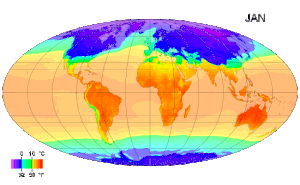Köppen
Monthly average surface temperatures from 1961–1990. This is an example of how climate varies with location and season
Monthly global images from NASA Earth Observatory
Main article: Köppen climate classification
The Köppen classification depends on average monthly values of temperature and precipitation. The most commonly used form of the Köppen classification has five primary types labeled A through E. These primary types are A, tropical; B, dry; C, mild mid-latitude; D, cold mid-latitude; and E, polar. The five primary classifications can be further divided into secondary classifications such as rain forest, monsoon, tropical savanna, humid subtropical, humid continental, oceanic climate, Mediterranean climate, steppe, subarctic climate, tundra, polar ice cap, and desert.Rain forests are characterized by high rainfall, with definitions setting minimum normal annual rainfall between 1,750 millimetres (69 in) and 2,000 millimetres (79 in). Mean monthly temperatures exceed 18 °C (64 °F) during all months of the year.[15]
A monsoon is a seasonal prevailing wind which lasts for several months, ushering in a region's rainy season.[16] Regions within North America, South America, Sub-Saharan Africa, Australia and East Asia are monsoon regimes.[17]
A tropical savanna is a grassland biome located in semiarid to semi-humid climate regions of subtropical and tropical latitudes, with average temperatures remain at or above 18 °C (64 °F) year round and rainfall between 750 millimetres (30 in) and 1,270 millimetres (50 in) a year. They are widespread on Africa, and are found in India, the northern parts of South America, Malaysia, and Australia.[18]


No comments:
Post a Comment